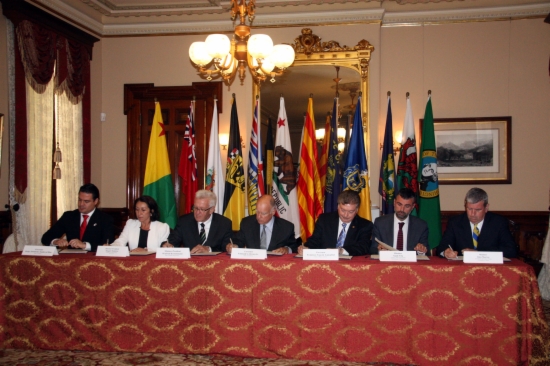Climate change agreement signed by California, Ontario, Catalonia and 9 other regional governments
On Tuesday, ahead of the United Nations conference on Climate Change to be held in Paris this autumn, Catalonia signed a 'Memorandum of Understanding' in Sacramento (California), together with 11 other US states, Mexican states, Canadian provinces and regional governments. By taking this step, the Catalan Government and the other signatories commit to cut total greenhouse emissions to 80%-95% below 1990 levels by 2050 or to cut per capita emissions to below 2 metric tons during the same timeframe. The 12 founding signatories to the agreement span seven countries and three continents, with a total population of 100 million people and about $4.5 trillion in combined GDP. Apart from Catalonia, the signatories include: California, Vermont, Oregon and Washington (USA); Acre (Brazil); Baden-Württemberg (Germany); Baja California and Jalisco (Mexico); Ontario and British Columbia (Canada); and Wales (UK). More states, nations and cities are expected to join the agreement in the coming months.

Barcelona (ACN).- On Tuesday, ahead of the United Nations conference on Climate Change to be held in Paris this autumn, Catalonia signed a 'Memorandum of Understanding' in Sacramento (California), together with 11 other US states, Mexican states, Canadian provinces and regional governments. By taking this step, the Catalan Government and the other signatories commit to cut total greenhouse emissions to 80%-95% below 1990 levels by 2050 or to cut per capita emissions to below 2 metric tons during the same timeframe. The 12 founding signatories to the agreement span seven countries and three continents, with a total population of 100 million people and about $4.5 trillion in combined GDP. Apart from Catalonia, the signatories include: California, Vermont, Oregon and Washington (USA); Acre (Brazil); Baden-Württemberg (Germany); Baja California and Jalisco (Mexico); Ontario and British Columbia (Canada); and Wales (UK). More states, nations and cities are expected to join the agreement in the coming months.
The agreement, called the 'Sub-national Global Climate Leadership Memorandum of Understanding', provides a template for the world to follow as work continues toward the next UN Climate Change Conference to be held in November and December in Paris. The final goal is to keep the increase in global average temperature to below 2 degrees Celsius - the threshold scientists have identified as likely to bring about catastrophic climate disruptions.
"California is probably one of the leading states with regard to environmental policies in the United States", commented Santi Vila, the Catalan Minister for Planning and Sustainability, who signed the Memorandum on behalf of the Catalan Government. "The agreement signed on Tuesday is very important in order to consolidate Catalonia's leadership in this field, especially among leading regions in Europe together with Baden-Württemberg", Vila underlined.
The aim of the Memorandum is that beyond states, stateless nations, regions and cities draw up alliances and coordinate in order to promote policies together. "There are many things we can do related to sustainable mobility, housing, goods transportation and infrastructure: all aspects having an impact on climate change", the Catalan Minister said. "In this vein, I think it is really positive that we are able to directly do something about it through our own powers", he highlighted.
The agreement firstly enables the exchange of experiences by identifying in which aspects the undersigning nations are competent and, at the same time, which good practices have been positive and can therefore be implemented by other nations.
The pact seeks to enhance cooperation through a range of activities, including: sharing of technology, scientific research and best practices to promote energy efficiency and renewable energy; collaboration to expand the use of zero-emission vehicles; improving air quality by reducing short-lived climate pollutants such as black carbon and methane.
The agreement's signatories have also committed to recruiting additional global partners ahead of the United Nations Climate Change Conference in Paris.
The regional level proved very efficient in the reduction of CO2 emissions
"Working at the regional level has proven to be a particularly efficient strategy when it comes to the reduction of CO2 emissions - the thorny issue - through mobility and territorial planning," Vila highlighted.
The Catalan Minister said that Catalonia is fully committed to the fight against climate change from all perspectives, through a series of initiatives aimed at achieving a balanced shift toward a greener paradigm. In particular, it plans to reduce by 2020 its greenhouse gas emissions by 27% in comparison to 2005 levels, achieving a 38% reduction by 2030.
To reach this goal, the Catalan Government will have to work on all fronts. Firstly, increasing energy efficiency by 20%, through the adoption of ‘ad hoc’ measures regarding the industrial, construction and transport sectors. Secondly, accounting for 20% of gross final energy consumption with green energy by promoting the use of wind and offshore wind, biomass and solar energy. Finally, encouraging sustainable mobility and reducing the carbon footprint of waste management.
In Catalonia, a new law on Climate Change is currently being prepared, whose approval is expected this year. This law draws new targets for reducing greenhouse gas emissions and sets down a pioneering strategy to combat climate change from the perspective of non-state authorities, Vila explained.
The Catalan Minister for Planning and Sustainability underlined that Catalonia is already suffering the consequences of climate change and understands the need to be a pioneer in this field, acting quickly. Therefore, the Catalan Government has approved the Catalan Strategy for Adaptation to Climate Change 2013-2020 which identifies geographic areas and activities particularly at risk due to climate change. Its focus lies on two main axes: the management of water resources and the adaptation of agriculture to the effects of climate change.